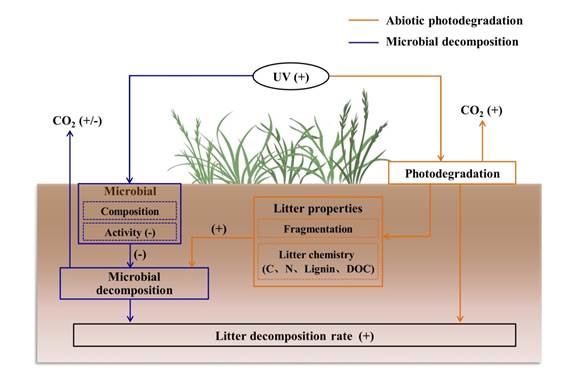Global Change Biol:中科院植物所刘玲莉组发表凋落物光降解研究进
随着全球经济飞速发展,人类活动不断向大气中排放大量颗粒物,导致大气气溶胶含量大幅度上升。大气气溶胶粒子能够吸收、散射太阳辐射,改变到达地球表面的太阳辐射量,太阳辐射的这些变化会显著地改变陆地生态系统的生物地球化学循环过程。以往关于太阳辐射变化的研究主要集中于其对植物光合作用以及植被生产力的影响,而对辐射变化如何影响地下碳氮循环的关注较少。中科院植物研究所刘玲莉研究组通过控制实验和数据整合相结合的方法,发现紫外线(UV)辐射会显著加速陆地生态系统中凋落物的分解,并且这种促进效应主要是通过增加凋落物的可降解性,进而促进生物降解。
刘玲莉组研究人员首先通过控制实验,对凋落物进行了两个不同水平的UV辐射处理。经过195天UV处理后发现,在土壤微生物存在的情况下,高UV辐射显著加速了凋落物的分解。而在没有土壤微生物存在的情况下,UV辐射对凋落物的降解没有显著影响。为了验证UV辐射是否增加了凋落物的可降解性,从而加速了凋落物的生物降解,研究人员将UV辐射处理后的凋落物与风干土混合后接种微生物进行培养。结果发现,UV辐射处理时间越长的凋落物,其可溶性有机碳含量越高,培养时累积释放的二氧化碳量也越高,即UV辐射使得凋落物的可降解性增加。
为了进一步验证这种现象是否具有普适性,研究人员通过数据整合分析的方法,将现有关于凋落物光降解的研究进行整合分析,比较了非生物光降解过程和微生物参与的光降解过程中凋落物的化学组成及降解速率的差异。结果验证了室内培养实验的结论,即紫外线辐射量的增加会显著地加速陆地生态系统中凋落物的分解速率,并且这种促进效应主要是通过增加凋落物的可降解性,进而促进生物降解。
此项研究揭示了凋落物降解过程中非生物光降解与微生物降解的交互作用,有助于全面理解辐射变化对陆地生态系统碳循环的影响。研究成果已发表于Global Change biology(doi: 10.1111/gcb.12812)。研究得到了国家重点基础研究发展计划(2013CB956304, 2014CB954003)、国家自然科学基金(13263A1001)和国家青年千人计划项目的资助。

UV辐射下非生物光降解与微生物降解对凋落物分解的影响机制
文章连接:
The interaction between abiotic photodegradation and microbial decomposition under ultraviolet rADIation
原文摘要:
Elevated ultraviolet (UV) radiation has been demonstrated to stimulate litter decomposition. Despite years of research, it is still not fully understood whether the acceleration in litter degradation is primarily attributed to abiotic photodegradation or the combined effects of abiotic photodegradation and microbial decomposition. In this study, we used meta-analysis to synthesize photodegradation studies and compared the effects of UV radiation on litter decomposition between abiotic and biotic conditions. We also conducted a microcosm experiment to assess the effects of UV radiation on litter biodegradability and microbial activity. Overall, our meta-analysis found that under abiotic photodegradation, UV radiation reduced the remaining litter mass by 1.44% (95% CI: 0.85% to 2.08%), did not affect the remaining lignin and increased the dissolved organic carbon (DOC) concentration by 14.01% (1.49–23.67%). Under combined abiotic photodegradation and microbial decomposition, UV radiation reduced the remaining litter mass and lignin by 1.60% (0.04–3.58%) and 16.07% (9.27–24.23%), respectively, but did not alter DOC concentration. UV radiation had no significant impact on soil microbial biomass carbon (MBC), but it reduced microbial respiration by 44.91% (2.26–78.62%) and altered the composition of the microbial community. In addition, UV radiation reduced nitrogen (N) immobilization by 19.44% (4.77–37.92%). Our microcosm experiment further indicated that DOC concentration and the amount of respired C in UV-treated litter increased with UV exposure time, suggesting that longer UV exposure resulted in greater biodegradability. Overall, our study suggested that UV exposure could increase litter biodegradability by increasing the microbial accessibility of lignin, as well as the labile carbon supply to microbes. However, the remaining litter mass was not different between the abiotic and biotic conditions, most likely because the positive effect of UV radiation on litter biodegradability was offset by its negative effect on microbial activity. Our results also suggested that UV radiation could alter the N cycle during decomposition, primarily by inhibiting N immobilization.
doi: 10.1111/gcb.12812
作者:刘玲莉

